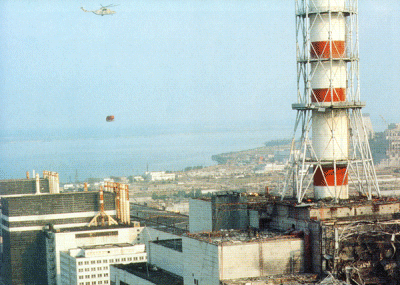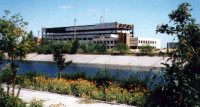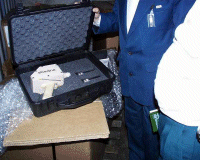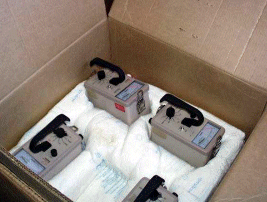Chornobyl Report
A biweekly update of Chornobyl support activities for June 12, 1998
Vent stack repairs complete!
 Flags of Ukraine, the United States, and Canada on the vent stack signify international cooperation |
Completion of the repair contract now requires cleanup of the work sites and dismantling of scaffolding, cranes, and the materials delivery system. Some of the scaffolding will be left in place to provide alternate stairways and access/egress routes for workers at the Shelter.
Formal documentation of project completion by the contractor, Ukrenergobud, and acceptance of the work by the Shelter will be provided on June 25. PNNL and CANATOM will visit the plant to physically verify completion of the repairs by walking down the work sites, reviewing the documentation, and receiving before-and-after photographs of the repairs.
Shelter management has informed PNNL that an event is being planned to recognize the significance of this project completion. This was the first international project providing real, physical safety improvement to the Shelter. In addition, it demonstrated Ukraine's ability to manage and perform high-quality work under an international contracting arrangement. The $2.25 million project was funded jointly by the United States ($1.0M), Canada ($800K), and Ukraine ($450K).
 The vent stack damaged in the 1986 accident as shown here has regained its full design strength. |
Heat plant construction progress
 Heat plant under construction. |
Authorization was issued recently for subcontracting pre-construction activities; revising the master schedule; and preparing for project, purchasing, and subcontracting. Five subcontract agreements were signed by PNNL and PCMG for the pre-construction work.
On-site assistance and mentoring is being provided by PNNL, with emphasis on the early stages of the project. This includes helping the PCMG with the tendering/bid process for subcontractors. PNNL is conducting a price-cost analysis of the budget proposal from the Ukrainian tender-winning design institute, Ukerenergoproject.
Efforts also involve working on the near-term actions required to proceed with the project. These include organizing the facility design drawings and developing the design index; preparing a bill of materials list; and preparing and revising statements of work for the first phase of tasks and activities.
Shelter accepts nuclear safety monitoring system
The $1.5M system for monitoring neutron and gamma fluxes near the fuel-containing masses in the Chornobyl Shelter has been formally accepted by the Shelter organization. Acceptance followed successful installation, startup, and testing. The testing was conducted in a laboratory of the Interdisciplinary Scientific and Technical Center (ISTC-Shelter) in the town of Chornobyl, south of ChNPP. ISTC -Shelter is under Ukraine's National Academy of Sciences.
PNNL staff assisted with the activities and also conducted training of Ukrainian personnel responsible for system installation and its subsequent operation in the Shelter. Training of the Ukrainians, who are experts in the operation of similar monitoring systems, covered instrument settings and calibration, software operation, neutron measurements and data interpretation, and system testing.
Tests demonstrated that the system functions appropriately and is ready for installation in the Shelter. Three problems were identified, two of which are remediable by modifications to procedures. One of the eight amplifiers in the instrumentation modules needs a minor repair, which PNNL will pursue with the manufacturer. Because the amplifiers are to be located in the shielded control room, the timing of the repair is not a concern.
In response to a request from Shelter personnel, PNNL staff agreed to return in early fall, after the system is installed, to check the operation of all channels and to ensure that all electronic settings are appropriate.
Information presented on Shelter project
Environmental and Safety Improvements at Chornobyl was the topic of a technical session at the American Nuclear Society Annual Meeting on June 9 in Nashville, Tennessee. PNNL and contractor staff presented papers on the status and accomplishments of the international Shelter project and the U.S. Department of Energy's safety improvement efforts to about 40 people during an afternoon session. Organized by Neil Norman, Parsons Infrastructure & Technology Group, and co-chaired by Wayne Johnson, also of Parsons, and Dennis Kreid, PNNL, the session included the following papers:
"Neutron Monitoring System for Evaluating Nuclear Safety in the Chornobyl Unit 4 Fuel Debris"- RI Sherpelz, JE Tanner, DR Sisk, and BF Gore, PNNL
"Chornobyl Shelter Implementation Plan - Project Development and Planning: Setting the Stage for Progress" - W Johnson, Parsons I&T; DK Kreid, PNNL; and W DeFranco, SAIC, Oak Ridge
"Dust Suppression and Contamination Control at Chornobyl Nuclear Power Plant's Unit 4" - W Johnson and JV Osterloh, Parsons I&T
"International Project to Repair Chornobyl Units 3 and 4 Ventilation Stack Supports" - JP Schmidt, JK Neal, and BF Gore, PNNL; JV Osterloh, Parsons I&T; and BV Winkel, M&D Professional Services
"Accident Assessment for Chornobyl Unit 3 from Potential Collapse of Adjacent Structures" - BF Gore, PNNL; IM Simonov and AB Kritsky, Ukraine's Ministry of Environmental Protection and Nuclear Safety
Chornobyl Center activities planned
Building in-country expertise in safe nuclear power plant operations continues to be one of the main objectives of the Chornobyl Center for Nuclear Safety, Radioactive Waste and Radioecology, and its primary technical branch, the Slavutych Laboratory for International Research and Technology. Within the next few months, two major events at the Chornobyl Center will support that initiative.
A technology commercialization workshop, sponsored by PNNL, is scheduled tentatively for September at the Slavutych Laboratory. The workshop will be conducted by PNNL staff for the benefit of Ukrainian institutes interested in commercial applications of their technologies. A questionnaire will be developed, distributed to participants, and returned prior to the workshop. The responses will be analyzed and used to tailor the content and materials used in the workshop to the specific needs and interests of the participants. This will ensure that the workshop is designed to address the major challenges and barriers to commercializing technology in Ukraine.
The second annual Chornobyl Conference is planned for October 13 through 16 at the Slavutych Laboratory. Program planning activities have begun, and more than 100 representatives of Ukrainian and international organizations are expected to attend to discuss international support for continued safety work at Chornobyl.
Additional information on the workshop and conference will be publicized as the dates draw nearer.
 |  |
| Dosimetry and radiation detection equipment is examined upon arrival. |  |
Equipment makes it through customs
The lengthy process of clearing safety-related equipment destined for ChNPP through Ukrainian customs was completed recently for several shipments. Dose reduction equipment, including dosimeters and radiation detection supplies, and additional personal protective clothing comprised the shipments that cleared customs and were delivered to the ChNPP site this month. Airless sprayer equipment and accessories to aid in dust suppression efforts at the Chornobyl Shelter also were released and delivered.
Some additional equipment for dust suppression, dose reduction, and industrial safety are still being held by customs for clearance.
See also the Biweekly Report Archives and Chornobyl Initiatives/General Information on Chornobyl